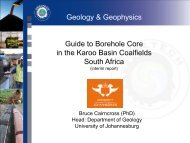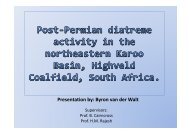coaltech upper olifants river catchment wetland inventory ...
coaltech upper olifants river catchment wetland inventory ...
coaltech upper olifants river catchment wetland inventory ...
You also want an ePaper? Increase the reach of your titles
YUMPU automatically turns print PDFs into web optimized ePapers that Google loves.
3.4 Wetland classification<br />
Wetlands can be classified according to different classification methods, based on the<br />
hydrological functioning, fauna and / or flora composition or diversity, soil, or a combination<br />
of these features. The classification method used mostly depends on the reason for<br />
classification. Botanists would mostly use vegetation composition to classify <strong>wetland</strong>s,<br />
whereas an ornithologist will mostly use bird habitat features as a defining criterion.<br />
Ecologists are, however, more interested in the interaction of different biotic and abiotic<br />
features within a system and will therefore use the complete system functioning as part of<br />
the classification (Ward & Lambie 1999, Allan et al 1995, Cowardin no date, Kiai & Mailu no<br />
date, http://dept.my.gov/wqinfo/<strong>wetland</strong>s/classification.asp). In addition, there are also<br />
various classification methods using remote sensing, depending on the percentage open<br />
water, type of vegetation cover and density of the vegetation cover (Dely et al 1999,<br />
Shanmugam et al in press).<br />
One of the most popular methods for the classification of <strong>wetland</strong>s is the fundamental<br />
hydrological functioning of the <strong>wetland</strong>. The <strong>wetland</strong>s are therefore classified into different<br />
hydro-geomorphic units. The hydro-geomorphic units differ from one project to another and<br />
from one specialist to another (Ward & Lambie 1999, Kotze et al 2005). The most popular<br />
<strong>wetland</strong> classification method used in South Africa is the classification of hydro-geomorphic<br />
units.<br />
The classification used by Kotze et al (2005) in WET-EcoServices is a classification using<br />
hydro-geomorphic units. This is a useful classification method for assessment of the<br />
functions and services of <strong>wetland</strong>s, since specific functions and services can be associated<br />
with each unit type, depending on site specific conditions. The level 1 assessment of Wet-<br />
EcoServices is a desktop study focussed on the hydro-geomorphic type of the <strong>wetland</strong>. The<br />
hydro-geomorphic types specified in Wet-EcoServices include floodplain, valley bottom with<br />
channel, valley bottom without channel, hillslope seepage feeding a water course, hillslope<br />
seepage not feeding a water course and depressions (pans).<br />
Palmer et al (2002) classified the <strong>wetland</strong>s into hydro-geomorphic units during the previous<br />
<strong>wetland</strong> <strong>inventory</strong>. Six broad hydro-geomorphic units were identified. The six units are Non-<br />
floodplain riparian, floodplain riparian, hillslope seepage, pans, other non-riparian and<br />
artificial <strong>wetland</strong>s.<br />
Wetland Database for UORC - 28 -




